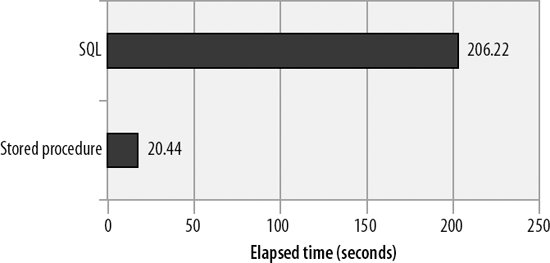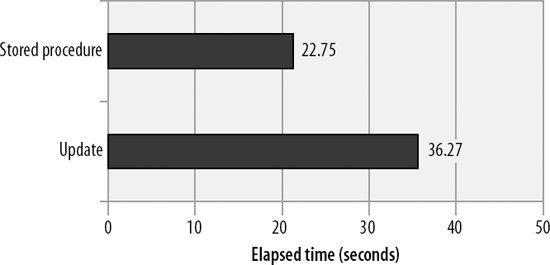Stored Programs as an Alternative to Expensive SQL
Sometimes we can use a stored program to perform query or DML operations that perform badly in standard SQL. This usually happens when the "pure" SQL statement becomes overly complex because of limitations in the SQL syntax or when the MySQL optimizer isn't able to come up with a sensible plan for your SQL query. In this section we offer two scenarios in which a stored program can be expected to outperform a SQL statement that executes the same logical steps.
22.4.1. Avoid Self-Joins with Procedural Logic
One situation in which a stored program might offer a better solution is where you are forced to construct a query that joins a table to itself in order to filter for the required rows. For instance, in Example 22-5, we issue a SQL statement that retrieves the most valuable order for each customer over the past few months.
Example 22-5. Finding the maximum sale for each customer
SELECT s.customer_id,s.product_id,s.quantity, s.sale_value FROM sales s, (SELECT customer_id,max(sale_value) max_sale_value FROM sales GROUP BY customer_id) t WHERE t.customer_id=s.customer_id AND t.max_sale_value=s.sale_value AND s.sale_date>date_sub(currdate( ),interval 6 month); |
This is an expensive SQL statement, partially because we first need to create a temporary table to hold the customer ID and maximum sale value and then join that back to the sales table to find the full details for each of those rows.
MySQL doesn't provide SQL syntax that would allow us to return this data without an expensive self-join. However, we can use a stored program to retrieve the data in a single pass through the sales table. Example 22-6 shows a stored program that stores maximum sales for each customer into a temporary table (max_sales_by_customer) from which we can later select the results.
Example 22-6. Stored program to return maximum sales for each customer over the last 6 months
1 CREATE PROCEDURE sp_max_sale_by_cust( ) 2 MODIFIES SQL DATA 3 BEGIN 4 DECLARE last_sale INT DEFAULT 0; 5 DECLARE l_last_customer_id INT DEFAULT -1; 6 DECLARE l_customer_id INT; 7 DECLARE l_product_id INT; 8 DECLARE l_quantity INT; 9 DECLARE l_sale_value DECIMAL(8,2); 10 DECLARE counter INT DEFAULT 0; 11 12 DECLARE sales_csr CURSOR FOR 13 SELECT customer_id,product_id,quantity, sale_value 14 FROM sales 15 WHERE sale_date>date_sub(currdate( ),interval 6 month) 16 ORDER BY customer_id,sale_value DESC; 17 18 DECLARE CONTINUE HANDLER FOR NOT FOUND SET last_sale=1; 19 20 OPEN sales_csr; 21 sales_loop: LOOP 22 FETCH sales_csr INTO l_customer_id,l_product_id,l_quantity,l_sale_value; 23 IF (last_sale=1) THEN 24 LEAVE sales_loop; 25 END IF; 26 27 IF l_customer_id <> l_last_customer_id THEN 28 /* This is a new customer so first row will be max sale*/ 29 INSERT INTO max_sales_by_customer 30 (customer_id,product_id,quantity,sale_value) 31 VALUES(l_customer_id,l_product_id,l_quantity,l_sale_value); 32 END IF; 33 34 SET l_last_customer_id=l_customer_id; 35 36 END LOOP; 37 38 END; |
Let's look at the most significant lines in this program:
|
Line(s) |
Explanation |
|---|---|
|
12 |
Declare a cursor that will return sales for the past 6 months ordered by customer_id and then by descending sale_value. |
|
27-32 |
Check to see whether we have encountered a new customer_id. The first row for any given customer will be the maximum sale for that customer, so we insert that row into a temporary table (line 30). |
The stored program is significantly faster than the standard SQL solution. Figure 22-3 shows the elapsed time for the two solutions.
Figure 22-3. Using a stored program to optimize a complex self-join

22.4.2. Optimize Correlated Updates
A correlated update is an UPDATE statement that contains a correlated subquery in the SET clause and/or WHERE clause. Correlated updates are often good candidates for optimization through procedural execution. In Example 22-7 we have an UPDATE statement that updates all customers who are also employees, and assigns the employee's manager as their sales representative.
Example 22-7. Correlated UPDATE statement
UPDATE customers c SET sales_rep_id = (SELECT manager_id FROM employees WHERE surname = c.contact_surname AND firstname = c.contact_firstname AND date_of_birth = c.date_of_birth) WHERE (contact_surname, contact_firstname, date_of_birth) IN (SELECT surname, firstname, date_of_birth FROM employees and ); |
Note that the UPDATE statement needs to access the employees table twice: once to identify customers who are employees and again to find the manager's identifier for those employees.
Example 22-8 offers a stored program that provides an alternative to the correlated update. The stored program identifies those customers who are also employees using a cursor. For each of the customers retrieved by the cursor, an UPDATE is issued.
Example 22-8. Stored program alternative to the correlated update
CREATE PROCEDURE sp_correlated_update( ) MODIFIES SQL DATA BEGIN DECLARE last_customer INT DEFAULT 0; DECLARE l_customer_id INT ; DECLARE l_manager_id INT; DECLARE cust_csr CURSOR FOR select c.customer_id,e.manager_id from customers c, employees e where e.surname=c.contact_surname and e.firstname=c.contact_firstname and e.date_of_birth=c.date_of_birth; DECLARE CONTINUE HANDLER FOR NOT FOUND SET last_customer=1; OPEN cust_csr; cust_loop: LOOP FETCH cust_csr INTO l_customer_id,l_manager_id; IF (last_customer=1) THEN LEAVE cust_loop; END IF; UPDATE customers SET sales_rep_id=l_manager_id WHERE customer_id=l_customer_id; END LOOP; END; |
Because the stored program does not have to do two separate accesses of the customers table, it is significantly faster than the standard SQL. Figure 22-4 compares the performance of the two approaches.
Figure 22-4. Performance of a correlated update and stored program alternative

Part I: Stored Programming Fundamentals
Introduction to MySQL Stored Programs
- Introduction to MySQL Stored Programs
- What Is a Stored Program?
- A Quick Tour
- Resources for Developers Using Stored Programs
- Some Words of Advice for Developers
- Conclusion
MySQL Stored Programming Tutorial
- MySQL Stored Programming Tutorial
- What You Will Need
- Our First Stored Procedure
- Variables
- Parameters
- Conditional Execution
- Loops
- Dealing with Errors
- Interacting with the Database
- Calling Stored Programs from Stored Programs
- Putting It All Together
- Stored Functions
- Triggers
- Calling a Stored Procedure from PHP
- Conclusion
Language Fundamentals
- Language Fundamentals
- Variables, Literals, Parameters, and Comments
- Operators
- Expressions
- Built-in Functions
- Data Types
- MySQL 5 Strict Mode
- Conclusion
Blocks, Conditional Statements, and Iterative Programming
- Blocks, Conditional Statements, and Iterative Programming
- Block Structure of Stored Programs
- Conditional Control
- Iterative Processing with Loops
- Conclusion
Using SQL in Stored Programming
- Using SQL in Stored Programming
- Using Non-SELECT SQL in Stored Programs
- Using SELECT Statements with an INTO Clause
- Creating and Using Cursors
- Using Unbounded SELECT Statements
- Performing Dynamic SQL with Prepared Statements
- Handling SQL Errors: A Preview
- Conclusion
Error Handling
- Error Handling
- Introduction to Error Handling
- Condition Handlers
- Named Conditions
- Missing SQL:2003 Features
- Putting It All Together
- Handling Stored Program Errors in the Calling Application
- Conclusion
Part II: Stored Program Construction
Creating and Maintaining Stored Programs
- Creating and Maintaining Stored Programs
- Creating Stored Programs
- Editing an Existing Stored Program
- SQL Statements for Managing Stored Programs
- Getting Information About Stored Programs
- Conclusion
Transaction Management
- Transaction Management
- Transactional Support in MySQL
- Defining a Transaction
- Working with Savepoints
- Transactions and Locks
- Transaction Design Guidelines
- Conclusion
MySQL Built-in Functions
- MySQL Built-in Functions
- String Functions
- Numeric Functions
- Date and Time Functions
- Other Functions
- Conclusion
Stored Functions
- Stored Functions
- Creating Stored Functions
- SQL Statements in Stored Functions
- Calling Stored Functions
- Using Stored Functions in SQL
- Conclusion
Triggers
Part III: Using MySQL Stored Programs in Applications
Using MySQL Stored Programs in Applications
- Using MySQL Stored Programs in Applications
- The Pros and Cons of Stored Programs in Modern Applications
- Advantages of Stored Programs
- Disadvantages of Stored Programs
- Calling Stored Programs from Application Code
- Conclusion
Using MySQL Stored Programs with PHP
- Using MySQL Stored Programs with PHP
- Options for Using MySQL with PHP
- Using PHP with the mysqli Extension
- Using MySQL with PHP Data Objects
- Conclusion
Using MySQL Stored Programs with Java
- Using MySQL Stored Programs with Java
- Review of JDBC Basics
- Using Stored Programs in JDBC
- Stored Programs and J2EE Applications
- Using Stored Procedures with Hibernate
- Using Stored Procedures with Spring
- Conclusion
Using MySQL Stored Programs with Perl
- Using MySQL Stored Programs with Perl
- Review of Perl DBD::mysql Basics
- Executing Stored Programs with DBD::mysql
- Conclusion
Using MySQL Stored Programs with Python
- Using MySQL Stored Programs with Python
- Installing the MySQLdb Extension
- MySQLdb Basics
- Using Stored Programs with MySQLdb
- A Complete Example
- Conclusion
Using MySQL Stored Programs with .NET
- Using MySQL Stored Programs with .NET
- Review of ADO.NET Basics
- Using Stored Programs in ADO.NET
- Using Stored Programs in ASP.NET
- Conclusion
Part IV: Optimizing Stored Programs
Stored Program Security
- Stored Program Security
- Permissions Required for Stored Programs
- Execution Mode Options for Stored Programs
- Stored Programs and Code Injection
- Conclusion
Tuning Stored Programs and Their SQL
- Tuning Stored Programs and Their SQL
- Why SQL Tuning Is So Important
- How MySQL Processes SQL
- SQL Tuning Statements and Practices
- About the Upcoming Examples
- Conclusion
Basic SQL Tuning
Advanced SQL Tuning
- Advanced SQL Tuning
- Tuning Subqueries
- Tuning Anti-Joins Using Subqueries
- Tuning Subqueries in the FROM Clause
- Tuning ORDER and GROUP BY
- Tuning DML (INSERT, UPDATE, DELETE)
- Conclusion
Optimizing Stored Program Code
- Optimizing Stored Program Code
- Performance Characteristics of Stored Programs
- How Fast Is the Stored Program Language?
- Reducing Network Traffic with Stored Programs
- Stored Programs as an Alternative to Expensive SQL
- Optimizing Loops
- IF and CASE Statements
- Recursion
- Cursors
- Trigger Overhead
- Conclusion
Best Practices in MySQL Stored Program Development
EAN: 2147483647
Pages: 208
